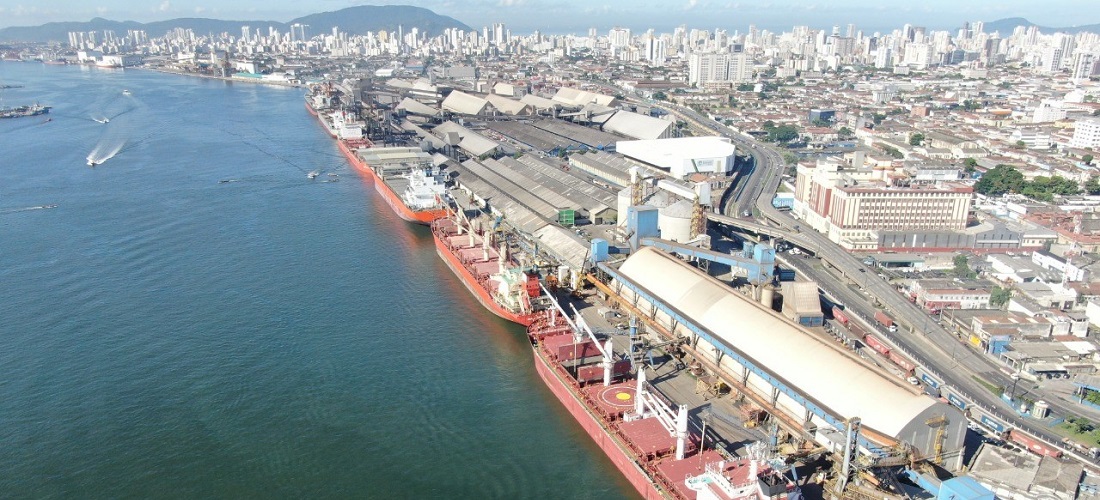
Cargo surge: Santos Port gears up for incoming grain season
Aug, 21, 2023 Posted by Gabriel MalheirosWeek 202335
A new wave of grain shipments is making its way to the Port of Santos. The latter half of the year is set to see a focus on corn, with most shipments in September, as well as sugar and soy, which have been flowing in high volumes for months. One of the regions most affected by this influx is the Estuary and Ponta da Praia area in Santos, where several terminals handle this type of cargo. To ensure smooth operations, the Port Authority of Santos (APS) and the Municipality of Santos are collaborating closely.
The first half of this year saw a record-breaking cargo throughput at the port, totaling 81 million tonnes. During the same period, the soy complex (grains and meal) witnessed a 10.4% increase compared to the previous year, reaching 29 million tonnes. Sugar followed suit with 8.1 million tonnes, marking a 4.8% growth from 2022. While these figures underscore the prowess of the Port of Santos complex, they also maintain authorities in a state of constant alert.
Efforts to alleviate traffic congestion include ongoing road construction near grain terminals, aiming to facilitate the passage of trucks carrying cargo not transported by rail. Furthermore, open communication between the APS and the City Hall plays a crucial role.
In theory, all road and rail activities related to the transport of harvest yields occur through railroads controlled by the Federal Government and highways operated by the State Government, mainly the Anchieta-Imigrantes System (SAI). From there, traffic shifts to perimeter avenues and internal roads within the Port of Santos, an area under federal jurisdiction. However, on the Right Bank of the Port of Santos (the insular area of the Municipality), interfaces exist between the perimeter road and roads under municipal management.
Since 2013, APS has employed a truck scheduling system, which has proven to be efficient, particularly in managing agri-food bulk operations, according to the City Hall.
Further improvents
The Port Authority of Santos (APS) is dedicated to elevating its standards to accommodate the growing cargo flow, particularly agricultural produce passing through the Port. With this objective in mind, enhancements are being made to the scheduling system, both in terms of regulations and rules. This involves regular meetings with grain terminals to fine-tune the physical system’s regulations. This includes installing control points along port roads to better monitor flow. However, that’s not the end of it.
The already-implemented infrastructure and improved port rules for berthing and handling are proving their effectiveness, as stated by the Port Authority. Moreover, this positive trend is expected to continue. For instance, the STS11, leased by Cofco, is undergoing expansion works. It’s set to become the country’s largest vegetable bulk terminal, capable of handling 14.3 million tons annually, enhancing productivity in handling soybeans, soy bran, corn, sugar, and unloading wheat.
The railway mode also plays a role in this improvement, as APS highlights. A third railway line has been constructed, involving investments of R$ 23 million, along with 1,962 meters of new rails for supporting empty wagon maneuvers, thereby freeing up the two existing railway lines.
The transfer of Marimex, announced this month, to a 102-thousand-square-meter area of the old Teval will allow for the establishment of a railway pear (a circular courtyard for cargo transshipment without the need to disassemble the train). This change will boost the outflow of vegetable bulk by 20 million tons/year, catering to 13 terminals on the right bank of the Port.
“In terms of road access, apart from interventions to be conducted alongside Fips (Internal Railroad of the Port of Santos) investments for road-rail crossings, revitalization efforts are ongoing on Avenida Perimetral da Margem Direita, funded by APS, in the Alemoa stretch. Additionally, improvements are being made in the Estuary region, including the internal avenue and a viaduct’s construction near Canal 4 and Ponta da Praia,” APS summarizes.
Source: A Tribuna
To read the original text, visit: https://www.atribuna.com.br/noticias/portomar/porto-de-santos-tera-nova-safra-de-graos-e-adaptacoes-para-receber-demanda
-
Ports and Terminals
Apr, 08, 2022
0
Sepetiba Tecon is awarded the Friend of the Navy medal
-
Other Logistics
Sep, 02, 2021
0
Reactivation of Barra Mansa – Angra railroad could boost agribusiness exports in Sul de Minas
-
Other Logistics
Jul, 08, 2022
0
Wilson Sons Logistics Center grows busier as automotive industry picks up in Brazil
-
Ports and Terminals
Oct, 21, 2021
0
Santos privatization to reduce shipping tariff by 30%


